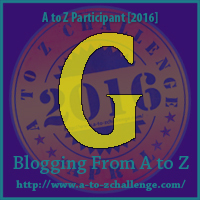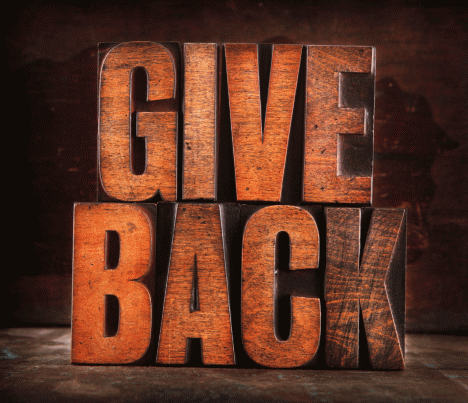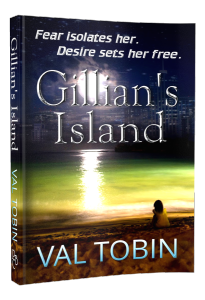Val Tobin's Blog, page 28
April 10, 2016
‘G’ is for Giving Back
Thank you, Pam, for being so generous with your time. Pam beta-read Gillian’s Island for me, and her insights were invaluable.

 Webster definition:
Webster definition:
Giveback:n. A previously negotiated workers’ benefit relinquished to management, as for some concession was given.
adj. 1. Accustomed (to) by habit, etc. 2. Specified. 3.assumed; granted – n. something assumed or accepted as fact.
As a writer, I love nothing more than sitting myself in the chair to write, write, write. The introvert side of me could easily ignore many aspects functioning as a human, such as having the balance of making a living, relationships, leisure time, and giving back to your community. In the writing community, there are plenty of ways to giveback all of which are incredibly rewarding.
Though, it’s still a struggle for me not to put my blinders on my writer’s eyes and just worry about writing my current story. My Finished manuscript calls out to me loud and clear. I like nothing more than abiding by my self-made…
View original post 514 more words


April 9, 2016
H is for Heckling #atozchallenge
In one Seinfeld episode, Kramer brings a date to Jerry’s show, and the woman heckles him. Seinfeld decides to retaliate by going to her place of employment and heckling her back, with, of course, unexpected consequences.
That episode, while hilarious, also illustrates the risk any creative person takes when putting their work out there for public consumption.
People say you need a thick skin to offer your work up for public consumption, which is true. If you write truthfully, you’ll offend someone sooner or later. Stephen King has said “If you intend to write as truthfully as you can, your days as a member of polite society are numbered, anyway.”
Every writer eventually gets negative reviews, and, while some of those reviews come in the form of constructive criticism, others are nasty personal attacks. When the attack comes, it’s difficult not to feel the effects in your core, but you have to shrug it off.
Until it crosses into your personal space.
I recently came across a post by Nora Roberts that addressed the problem of readers showing up at her site and criticizing her work. The poster’s defence for doing so is that it’s an opinion.
In response to this, Roberts says, “Readers are absolutely entitled to opinions, and there are a zillion places on the internet to express any dissatisfaction. I’m not going to go onto those sites and debate with a reader over her opinion on my work. But these are my pages.”
Before the Internet, authors might receive mail criticizing their work, but the lambasting and harshness was done in private. I’m sure it still stung, though. Creative people tend to be sensitive, and it doesn’t matter how often they repeat the mantra that they need a thick skin and sticks and stones yadda yadda yadda.
Now it’s possible to publicly trash an author even on their personal page.
Roberts had enough after a poster called her stories predictable and that it didn’t take much brain power to read them. She responded with this: “That crossed a line for me. It’s not only insulting my work on my page, but insulting every reader who enjoys the work. That’s a frigging bitch-slap to everyone.”
She’s right.
Reviews of a story should be posted on review sites. An author’s site isn’t the place to trash that author’s work or his/her fans. I love that Nora Roberts assertively defended her space.


History: atozchallenge
Fascinating blog post on the value of learning history.
When I was fourteen I was faced with a choice. I had to decide which 8 subjects I was going to study over the next two years leading to the GCE ‘O’ level examination. For those who are not familiar with the school leaving examinations in Britain in the 1950s, the initials stand for General Certificate of Education, Ordinary level. This exam was taken by a relatively small proportion of 16 year-olds. An even smaller proportion continued for a further two years and took ‘A’ (for advanced) level GCEs in 2 or 3 subjects leading either to university or a training place in a profession like law or accountancy. The majority of young people left school and entered the workforce at age 15.
The choice for me and my colleagues was fairly simple. Six subjects were compulsory: Maths, English (Language and Literature), French, Latin and Physics. The choices were limited…
View original post 909 more words


April 8, 2016
G is for Gillian’s Island #atozchallenge

Gillian’s Island
In another month, my current WIP will be available for purchase or borrow on Amazon.
Gillian’s Island is a romantic suspense and tells the story of a socially anxious divorcée who confronts her greatest fears when she’s forced to sell her island home and falls for the dashing new owner.
Forced to sell her island resort after a messy divorce, Gillian Foster must now teach new owner Daylin Quinn how to run it. But someone resents Daylin’s presence on the island more than Gillian does and will stop at nothing to run him off—even if it costs Gillian her life.
Available May 2016.


April 7, 2016
F is for Food #atozchallenge
Anything important in our lives usually includes food:
Many relationships begin with a first-date dinner.
Holidays bring us together with loved ones where food plays a large role.
People give food as gifts on various occasions.
Weddings, baptisms, and even funerals have food.
Food can be used as reward or punishment.
Eating habits and relationship to food reveal a lot about a person.
I enjoy playing around with food in my stories. In some stories it features more prominently than in others, but it’s always there.
In Storm Lake, it was presented from the children’s perspective, and at one point, Rachel thinks about one meal as if it were their last.
Food pokes its head up periodically in The Experiencers as first something shared communally, and then later as something to be acquired to sustain life.
From the beginning of A Ring of Truth, food is used as a bribe and a tool to manipulate. Later it features as something simple to be shared and enjoyed.
In Injury, Dani’s insecurities and low self-esteem were evidenced by her relationship with food. When the story begins, she’s just starting a healthier relationship with food. Cope and Dani’s relationship evolves with their meals. Some meals they have in public places where something as simple as going out for dinner becomes a media circus.
Gillian, in Gillian’s Island, uses food at various times as comfort or as a shield.
In Walk-In, Viktoria eats to be healthy, so she wants to be careful with what she eats. But her family is Hungarian, and Hungarian food is traditionally rich and heavy.
Part of what I consider important when I map out a character is understanding how that character relates to food. A lot can be shown by simply having a character declare she or he refuses to eat meat. In A Ring of Truth, meat repulses Carolyn. Why it does is significant.
Scenes where people are eating reveal a lot. Who mows down without speaking? Who talks their way through a meal? Who tries to hide that they’re not eating? Who can’t eat because they’re too upset?
Obviously, these scenes must move the story forward or they shouldn’t be there, but I find an author’s use of food in a story fascinating.
The first food scene in a story that got me thinking about this is from The Lord of the Rings, which I first read when I was fourteen.
In chapter four, “A Shortcut to Mushrooms,” the Hobbits visit with a farmer whose mushrooms they used to steal when they were younger. Hobbits love mushrooms and can’t get enough of them.
I used to hate mushrooms.
But after I finished reading that chapter, I would have killed for some mushrooms. Since then, I’ve found that I can’t eat certain kinds of mushrooms (shiitake and oyster mushrooms will give me violent stomach pain), but I do enjoy the other types.
Chocolate was always my weakness. When I read Charlie and the Chocolate Factory as a kid, I loaded up on chocolate first. Don’t get me started on Chocolat.
Another favourite series where food features is The Narnia Chronicles. Boy was I disappointed when I finally tried Turkish Delight after reading The Lion, The Witch, and the Wardrobe.
Nora Roberts also uses food in her novels, and one of her books even included some of her favourite recipes at the end.
I’ll never forget the main character in Margaret Attwood’s A Handmaid’s Tale buttering her hands, or how Atwood used food in The Edible Woman and The Robber Bride.
What novels have you devoured that feature food?


April 6, 2016
E is for eBooks #atozchallenge
I’m reading more eBooks these days, though I still prefer paperbacks and hardcovers.
My spike in eBook reading is the result of getting a new tablet, which makes eBook reading easier and more convenient. Before, I was using my PC, and, while it has a nice, big screen, it’s uncomfortable.
I’m already hunched over my keyboard all day working, so I’d rather get my eyes off the screen when I’m reading for pleasure, research, or work (which, let’s face it, can all be lumped under pleasure if it involves reading).
While I’d never take my tablet down to the dock to read, I love using it when I work out on the elliptical trainer, when travelling, and when reading in bed at night with the lights off. It gives me access to hundreds of books and fits into a purse.
Most of the eBooks I read are by indie authors. I think out of the hundreds I’ve got available on my tablet now, only one is by a famous author.
Why? Because eBooks by traditionally published authors are priced too high.
Every once-in-a-while I’ll read some article saying that eBook sales are declining and people are returning to print. I suspect it’s mostly those who are involved in traditional publishing that are seeing this decline and lamenting it. Yet every time they whine about this, it’s pointed out that since they price their eBooks the same as or greater than their paperbacks, well, duh. I’m not even going to finish that thought.
When it comes to big-name traditionally published authors, I read the paperback or hardcover. Typically, I can find whatever I want at the library or in a used bookstore or at a friend’s house or at the book exchange. If I love it, I’ll buy it new and add it to my collection.
What’s wonderful about this situation is that the big five publishers have removed themselves as competition for our reading dollars when it comes to eBooks. They don’t participate in KS, so almost all the books in KU/KOLL are by indie authors. If someone is searching for a book to add to their eReader, prices for indie-authored books are far more reasonable.
A goldmine of well-written indie books exists. You just have to dig, and when you find an author you like, they usually have multiple books available. Many have the first in the series set to permafree, so you can try out the author risk free.
It’s a wonderful time to be addicted to reading.


Kurt Cobain in utero: My role model for being a Male Ally
Jeff Perera looks at one of his first male role models for speaking up against gender inequality: Kurt Cobain.
Jeff Perera looks at one of his first male role models for speaking up against gender inequality: Kurt Cobain.
“Never met a wise man, if so it’s a woman”
– Kurt Cobain , Territorial Pissings
In the midst of a 1991 audio swamp of conservative, manufactured pop music and ‘cock’ rock, a new sound shot out of the water. A sound that rose up from the Northwest, born of Riot Grrl feminist punk rock, and the broken home of a waitress and mechanic.
Nirvana was a return to music coming from a raw, primal and pure place. With songs like Negative Creep expressing his disdain, Kurt Cobain lived life as a middle finger to macho-jock culture.
One can only image his torment to end up performing in front of ravenous mosh-pits infected with the very jocks, jerks, macho creeps and toxic masculinity that his music rejected.
‘In Utero’ is my favourite album of all-time…
View original post 608 more words


April 5, 2016
D is for Death #AtoZChallenge
The type of death I’m writing about here is a character’s death in a story. Despite the death being fictional, it can still arouse grief and even anger in the reader.
I’m dealing with a probable fictional death right now.
The first time I encountered it as a reader, I was around ten and reading the Anne of Green Gables series of books. Anne’s friend died of consumption.
I was stunned.
How could this have happened? Sure, the girl had been sick, but it was a story. Why didn’t the author make it all okay in the end?
That was the first time I had to consider that books might reflect reality.
I think my childhood ended that day.
Since then, I’ve experienced thousands of fictional deaths, and most of them, on reflection, were warrented because they move the story forward or develop character.
But that doesn’t mean it won’t piss me off when it happens.
I’m reading Stephen King’s Mr. Mercedes right now, and if you’ve ever read any Stephen King, you’ll know no one is safe.
I’m already getting irritated, because I just know at least one character I like will buy it before the end. I’m sure I know who, too.
There are no HEA endings in King’s world, so even when good triumphs over evil, it’s not like the lovers get to walk off into the sunset together.
Does he always have to be so cruel?
As a reader, I want the HEA, good and love victorious over evil and hate. But the writer in me knows that’s not always best for the story, so I’ve killed my fair share of nice guys and parted lovers through death.
Mad as I’m going to get by the end of Mr. Mercedes, I’ll understand why King has it play out that way.
I’m tempted to set it aside for a while and read a Nora Roberts romance to bring in some light. Then I can come back to the darkness of King’s story.
This reminds me of that episode of Friends where Joey and Rachel swap favourite books, and Joey reads Little Women while Rachel reads The Shining.
Maybe I’ll put Mr. Mercedes in the freezer for a while.
If you already know what happens, don’t tell me. No doing what Rachel did to Joey.


April 4, 2016
Amazon, you hit like a bitch.
Amazon at it again removing reviews that aren’t fake.
It’s taken me a bit of time to write this post, but I figured it’s about time to share the utter nonsense that’s happened between me and Amazon, and how a company that I once highly respected, has now become one that I have zero respect for.
I’ve thought about writing this post for weeks, what I would say and how I would capture everything that’s happened, and I’ll be honest with the fact that this post has taken on many forms, but finally I decided that it would just be easiest to state the facts.
So here it goes…
 This is the first email I got from Amazon. As some of you know, on February 24th I was sent an email from Amazon letting me know that I could no longer post reviews on their website, and that all of my previous reviews had been suppressed or removed…
This is the first email I got from Amazon. As some of you know, on February 24th I was sent an email from Amazon letting me know that I could no longer post reviews on their website, and that all of my previous reviews had been suppressed or removed…
View original post 2,034 more words


C is for Covers #atozchallenge
Book covers fascinate me.
I understand you shouldn’t judge a book by its cover, but I find it difficult not to. Check out this list on Bored Panda and see if you’d pay money to read any of them after viewing the covers.
I admire anyone who can design a beautiful cover.
I’ve done one DIY cover, and I’m not proud of it. But the story is available for free and it was either money for editing or money for a cover, and the editing won. I do plan to have it redone when I can afford to squeeze out the coin.
Indie-book covers are hard-won. Most indie authors don’t make enough money to cover the cost of the expenses associated with publishing a book–not at first, anyway. So I’d like to honour some lovely covers I’ve come across.
Ten compelling indie-book covers/sets of covers (of course the covers for my books are on the list–they’re gorgeous):
The Valiant Chronicles Series: The Experiencers and A Ring of Truth : Design by Patti Roberts of Paradox Book Covers.
Injury : Design by Patti Roberts of Paradox Book Covers. Patti’s covers for my forthcoming releases, Gillian’s Island and Walk-In are just as spectacular and will be revealed soon.
Skin Cage : Design by Nico Laeser. There’s nothing Nico Laeser can’t do. He writes beautifully and his art is phenomenal.
Harmonic Resonance : Design by Nico Laeser
New Age Noir series: Felonious Monk and Soma County : Design by Linda Tenenbaum.
Origins : I don’t know who did this cover, but it catches my attention every time I see it.
Seer of Souls : Cover design by Greg Simanson.
The Institute Series: The Institute , Resistance , and Defective . Design by Wicked Book Covers.
The Thief Who Stole Eternity (book two of the Infinte series): Design by FLAFI Design.
Amsterdam Calling : Design by Amy Covenay of Author Design Studio.
There are many more gorgeous covers out there, but these in particular caught my eye.
After the cover, the blurb, reviews, and the sample have to pass muster for me to buy, but, fair or not, it’s always the cover that hooks me first.











